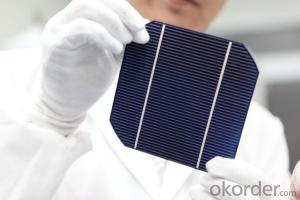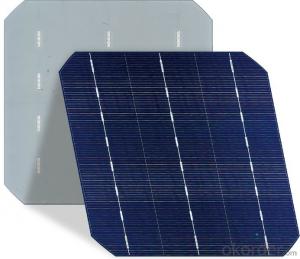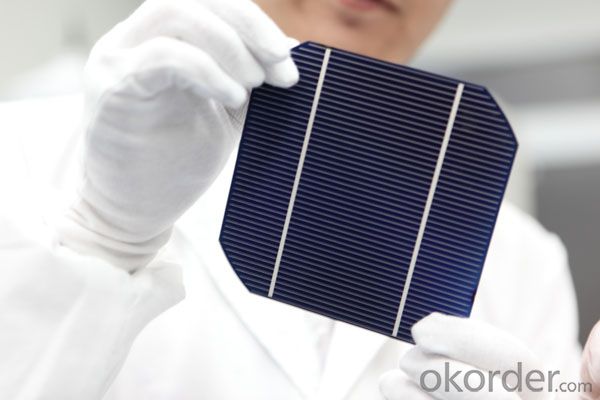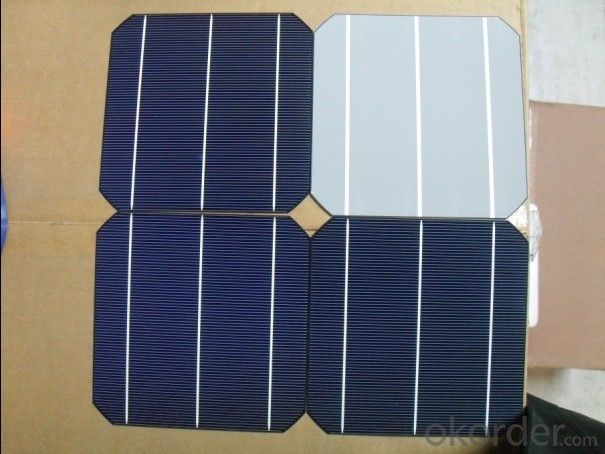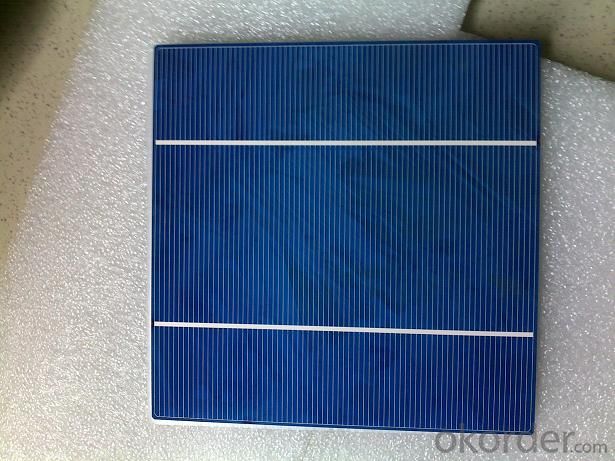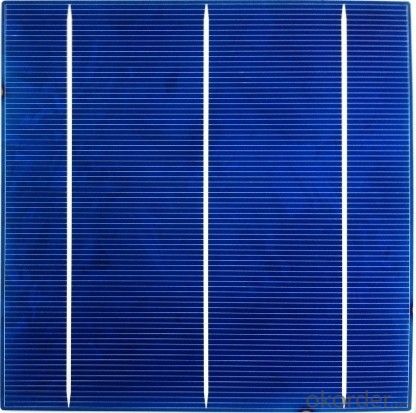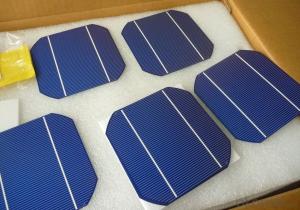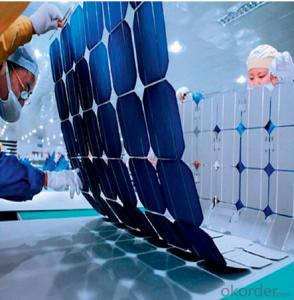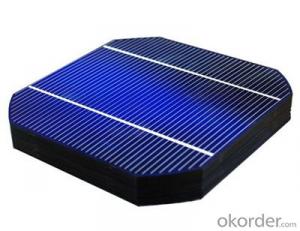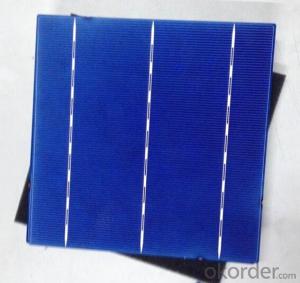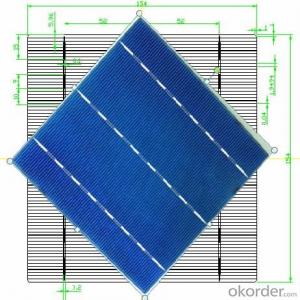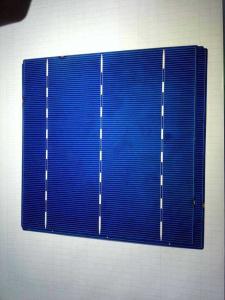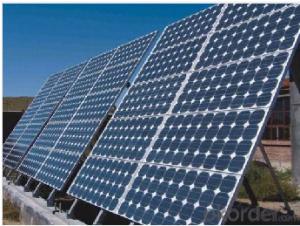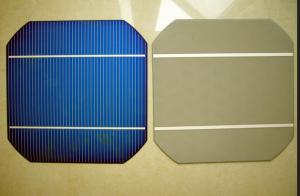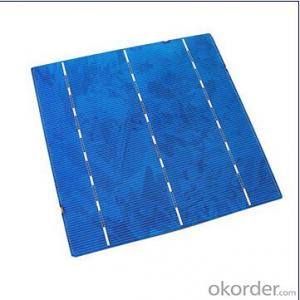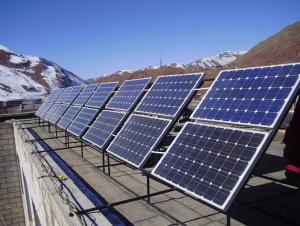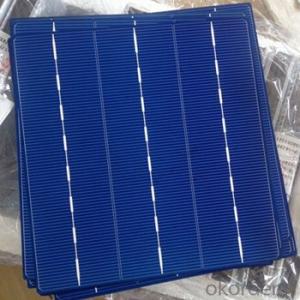CdTe Thin Film Solar Cells - Monocrystalline Silicon Solar Cells 156mm (16.50%-18.35%)
- Loading Port:
- Shanghai
- Payment Terms:
- TT OR LC
- Min Order Qty:
- 1000 watt
- Supply Capability:
- 100000000 watt/month
OKorder Service Pledge
OKorder Financial Service
You Might Also Like
Specification
1.Description of the Solar Cells
Monocrytalline Silicon Solar Cells 156mm (16.50%----18.35%)
We supply regular mono 125x125mm and poly 156x156mm solar cells.
Cells made in China mainland and Taiwan are both available.
Cell production capacity yearly reach 1GW.
Our cells pattern include continuous and uncontinuous busbar to meet different cells line.
2.Mechanical data and design of the Solar Cells
| Format | 156 mm × 156 mm ± 0.5 mm |
| Thickness- | 210 μm ± 40 μm |
| Front (-) | 1.5 mm bus bars (silver),blue anti-reflection coating (silicon nitride) |
| Back (+) | 2.5 mm wide soldering pads (silver) back surface field (aluminium) |
3. Temperature Coefficient of the Solar Cells
| Voc. Temp .coef.%/K | -0.35%/K |
| Isc . Temp .coef.%/K | +0.024%/K |
| Pm. Temp. coef.%/K | -0.47%/K |
4.Electrical Characteristic of the Solar Cells
Efficiency (%) | Pmpp (W) | Umpp (V) | Impp (A) | Uoc (V) | Isc (A) | FF (%) | ||
18.35 | 4.384 | 0.526 | 8.333 | 0.63 | 8.877 | 78.39% | ||
18.20 | 4.349 | 0.526 | 8.263 | 0.63 | 8.789 | 78.54% | ||
18.05 | 4.313 | 0.525 | 8.216 | 0.63 | 8.741 | 78.32% | ||
17.90 | 4.277 | 0.524 | 8.161 | 0.629 | 8.713 | 78.04% | ||
17.75 | 4.241 | 0.523 | 8.116 | 0.629 | 8.678 | 77.70% | ||
17.60 | 4.206 | 0.521 | 8.073 | 0.628 | 8.657 | 77.36% | ||
17.45 | 4.170 | 0.519 | 8.039 | 0.628 | 8.633 | 76.92% | ||
17.30 | 4.134 | 0.517 | 8.004 | 0.626 | 8.622 | 76.59% | ||
17.15 | 4.098 | 0.516 | 7.938 | 0.625 | 8.537 | 76.80% | ||
17.00 | 4.062 | 0.512 | 7.933 | 0.625 | 8.531 | 76.18% | ||
16.75 | 4.002 | 0.511 | 7.828 | 0.625 | 8.499 | 75.34% | ||
16.50 | 3.943 | 0.510 | 7.731 | 0.625 | 8.484 | 74.36% | ||
5.Intensity Dependence of the Solar Cells
Intensity [W/m2] | sc× [mA] | Voc× [mV] |
1000 | 1.00 | 1.000 |
900 | 0.90 | 0.989 |
500 | 0.50 | 0.963 |
300 | 0.30 | 0.939 |
200 | 0.20 | 0.920 |
6.Applications of the Solar Cells
electric power generation
7.IMages of the Solar Cells

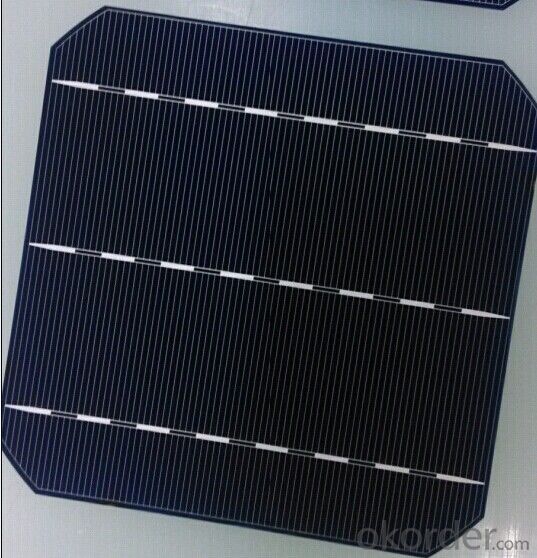
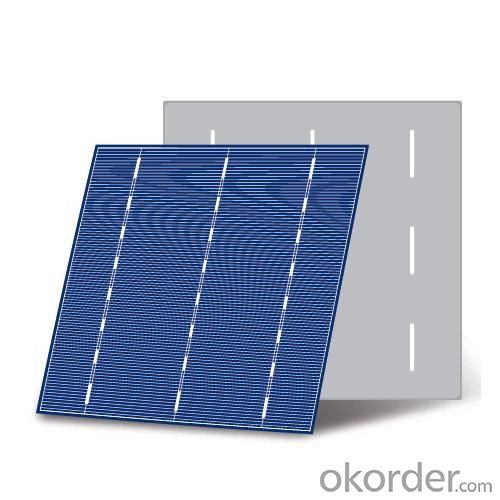
FAQ
- Q: Can solar cells be used in emergency lighting?
- Yes, solar cells can be used in emergency lighting. Solar-powered emergency lights are designed to provide illumination during power outages or emergencies by utilizing solar panels to convert sunlight into electricity, which is then stored in batteries for later use. This makes them a reliable and sustainable option for emergency lighting solutions.
- Q: What is the solar cells market in China?
- Solar cells, is the "ideal" energy of human being's life, solar energy has changed the traditional way of obtaining energy by battery technology. But this technology is limited due to what solar cells needs to work- the weather factors, the solar energy battery can not work properly under rainy or cloudy weather. Therefore, solar cells market is not very well developed in some part of China where there are not much sun.
- Q: How do solar cells impact energy security?
- Solar cells have a positive impact on energy security as they provide a reliable and sustainable source of electricity. By harnessing the power of the sun, solar cells reduce dependence on finite fossil fuels, increasing energy independence and reducing the risks associated with fluctuating fuel prices and geopolitical conflicts. Additionally, solar energy can be generated locally, reducing the vulnerability of energy supply chains and enhancing resilience in the face of natural disasters or other disruptions. Overall, solar cells play a crucial role in diversifying the energy mix and enhancing energy security for individuals, communities, and nations.
- Q: What are thin-film solar cells?
- Thin-film solar cells are a type of solar cell that utilize thin layers of semiconducting materials to convert sunlight into electricity. These cells are made by depositing thin films of photovoltaic materials onto a substrate, which allows for more flexible and lightweight solar panels compared to traditional silicon-based ones.
- Q: What is 3d solar cell? And anybody know any manufacturers?
- 3d solar cell is 3-dimensional silicon solar cell, which is is designed to maximize the conversion of sunlight into electricity.
- Q: How do solar cells impact energy independence?
- Solar cells impact energy independence by providing a renewable and sustainable source of electricity. They reduce dependence on fossil fuels and foreign oil, allowing countries and individuals to generate their own clean energy. Solar cells can be installed on rooftops, in remote areas, or even integrated into buildings, enabling individuals and communities to become self-sufficient and less reliant on centralized power grids. Ultimately, solar cells contribute to reducing carbon emissions and promoting long-term energy independence.
- Q: Can solar cells be used in underwater vehicles or submarines?
- Yes, solar cells can be used in underwater vehicles or submarines. However, due to the limited availability of sunlight underwater, the efficiency of solar cells in generating power is significantly reduced. Therefore, solar cells are often used as a supplementary power source in combination with other power systems such as batteries or fuel cells in underwater vehicles or submarines.
- Q: Can solar cells be used in floating solar farms?
- Yes, solar cells can definitely be used in floating solar farms. Floating solar farms, also known as floating solar panels or floating photovoltaic (PV) systems, are an innovative approach to harness solar energy by placing solar panels on a body of water. These systems offer several advantages such as increased energy efficiency due to the cooling effect of water, reduced land requirements, and minimized evaporation from the water surface. Therefore, solar cells are a suitable and effective solution for generating renewable energy in floating solar farms.
- Q: How are solar cells installed?
- Solar cells are typically installed on rooftops or in open spaces where they can receive maximum sunlight. The installation process involves mounting the solar panels onto a structure using brackets or frames. The panels are then connected to an inverter, which converts the direct current (DC) generated by the cells into alternating current (AC) for use in homes or businesses. Finally, the system is connected to the electrical grid or battery storage, allowing for the utilization of solar energy.
- Q: How are solar cells installed on rooftops?
- Solar cells are typically installed on rooftops by first assessing the suitability of the roof for solar panel installation. Once determined, the installation process involves positioning and securing racking or mounting systems on the roof surface. Then, solar panels are mounted onto the racking, connected to one another, and wired to an inverter. Finally, the inverter is connected to the electrical system of the building, allowing the generated solar power to be used.
Send your message to us
CdTe Thin Film Solar Cells - Monocrystalline Silicon Solar Cells 156mm (16.50%-18.35%)
- Loading Port:
- Shanghai
- Payment Terms:
- TT OR LC
- Min Order Qty:
- 1000 watt
- Supply Capability:
- 100000000 watt/month
OKorder Service Pledge
OKorder Financial Service
Similar products
Hot products
Hot Searches
Related keywords
